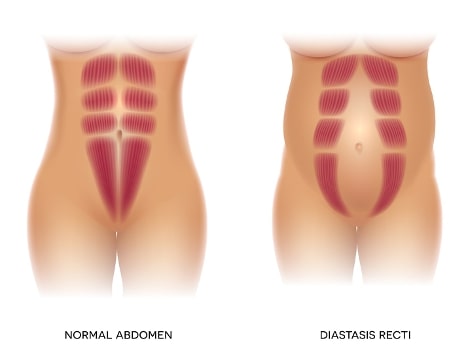Diastasis recti is when the large parallel muscle bands (rectus abdominis muscles) that normally meet in the middle of your abdomen get stretched out and separate. This can cause a bulge down the middle of your abdomen, most noticeable when tensing the muscles such as sitting up from a lying position. It does not pose any medical risk but can create an unsightly bulge despite diet and exercise. It may also be associated with muscle imbalance and low back pain since the abdominal muscles are not positioned optimally. Diastasis is most commonly associated with pregnancy, as the uterus grows and stretches the muscles in the abdomen to accommodate the growing baby. Indeed, it can be seen in up to 66% of women in the third trimester of pregnancy. It will often resolve or improve by 1 year postpartum, but can persist in up to 30-60% of women. Diastasis can also be seen in both men and women following significant weight gain, as the accumulating visceral fat stretches out the abdominal wall.
What are the Symptoms of Diastasis Recti?
- your body feels imbalanced
- ongoing lower back pain
- a tummy that is bulging or “poochy”
- when you sit up, you can see a trench running vertically down your belly
- it feels harder to sit or stand tall
- lifting or holding your children feels hard
Diastasis can sometimes improve with targeted exercises or physical therapy. However, a very wide diastasis will likely require surgery to repair. Dr.Won always investigates for diastasis in her tummy tuck patients, and will repair it at the time of the surgery. This entails plicating, or folding, the top layer that is stretched out (the rectus sheath) and bringing the muscles back to the midline with suture. This will eliminate the bulging seen in diastasis and create a more flat, attractive contour.

